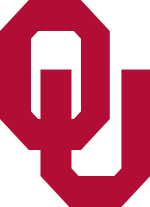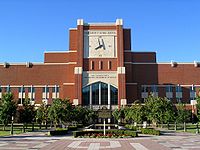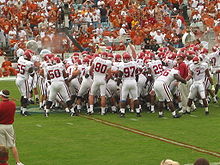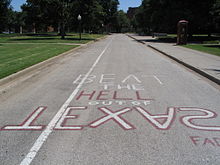- Oklahoma Sooners
-
Oklahoma Sooners University University of Oklahoma Conference(s) Big 12 Conference
Conference USA[A 1]NCAA Division I Athletics director Joe Castiglione Location Norman, OK Varsity teams 19 Football stadium Gaylord Family Oklahoma Memorial Stadium Basketball arena Lloyd Noble Center Baseball stadium L. Dale Mitchell Baseball Park Other arenas Headington Tennis Center
McCasland Field House
Vierson Gymnastics CenterMascot Sooner Schooner Nickname Sooners Fight song Boomer Sooner Colors Crimson and Cream Homepage SoonerSports The University of Oklahoma features 19 varsity sports teams. Both men's and women's teams are called the Sooners, a nickname given to the early participants in the land rushes which initially opened the Oklahoma Indian Territory to non-native settlement. They participate in the NCAA's Division I-A, in the Big 12 Conference. The University's current athletic director is Joe Castiglione.
In 2002, The University of Oklahoma was ranked as the 3rd best college sports program in America by Sports Illustrated.[1] When combined with Blake Griffin's John Wooden Award and Sam Bradford's Heisman Trophy, Oklahoma became the second school to have a top winner in both basketball and football in the same year (Gary Beban won the Heisman Trophy and Kareem Abdul-Jabbar won the USBWA "Player of the Year" award in 1968 for UCLA).
Contents
Varsity sports
The University of Oklahoma was a charter member of the Southwest Athletic Conference (SWC) during its formation in 1914. Five years later, in 1919, OU left the SWC and joined the Missouri Valley Intercollegiate Athletic Association. In 1928, this conference split, and OU remained aligned with the teams that formed the Big Six Conference. Over the next 31 years, more schools were added and the conference underwent several name changes, incrementing the number each time up to the Big Eight Conference where it remained until 1996. Four more universities were added then and the name was changed one more time to its current form: the Big 12 Conference.
The Oklahoma Sooners are represented in the following NCAA Division I varsity sports:
- Men's sports
- Baseball
- Basketball
- Cross country
- Football
- Golf
- Gymnastics
- Tennis
- Track and field
- Wrestling
- Women's sports
- Basketball
- Cross country
- Golf
- Gymnastics
- Rowing
- Soccer
- Softball
- Tennis
- Track and field
- Volleyball
Football
Main article: Oklahoma Sooners footballThe Sooners have been participating in college football since 1895. Calling Gaylord Family Oklahoma Memorial Stadium at Owen Field home, the team has won numerous bowl games, 41 conference championships (including every Big Seven championship awarded), and seven Associated Press National Championships, making the Sooners football program the most decorated in the Big 12. Oklahoma has scored the most points in Division I-A football history despite the fact they have played over 60 fewer games than the second place school on that list.[2] OU also has the highest winning percentage of any team since the start of the AP poll in 1936.[3]
The Sooners possess seven national championships in football, with the 1950, 1955, 1956, 1974, 1975, 1985, and 2000 seasons featuring the top team in the Associated Press final poll, and the 2000 Bowl Championship Series National Championship as well. This is 2nd to the Alabama Crimson Tide and Notre Dame Fighting Irish and tied with the USC Trojans for the most national titles of any Division I college football team after the end of World War II (which is commonly used as the division between eras in college football).[4][5]
In addition to these seven acknowledged national championships there are also nine additional years in which the NCAA's official record book recognizes the Sooners as national champions: 1949, 1953, 1957, 1967, 1973, 1978, 1980, 1986, 2003.[6] The University of Oklahoma does not acknowledge these additional "championships", as they were not awarded by the Associated Press, United Press International (UPI), USA Today Coaches Poll, or the Bowl Championship Series (BCS).
Individual success is also a major part of Oklahoma football; five Heisman Trophy winners (Billy Vessels, Steve Owens, Billy Sims, Jason White and Sam Bradford) are surrounded by many other award winners, including Adrian Peterson, Joe Washington, Brian Bosworth, Tony Casillas, Greg Pruitt, Josh Heupel, Jerry Tubbs, Rocky Calmus, Granville Liggins, Teddy Lehman, Lee Roy Selmon, Roy Williams, Tommy McDonald, Mark Clayton, Tommie Harris, J.C. Watts, Keith Jackson and Jammal Brown. More than a dozen Sooner players have been inducted into the College Football Hall of Fame. Oklahoma has more Butkus award winners than any other school.
Legendary coaches Bennie Owen, Bud Wilkinson, and Barry Switzer have passed through the gameday tunnel for the Sooners, each on their way to the College Football Hall of Fame. Owen was the first highly successful coach at OU and was a major advocate of the forward pass, which at the turn of the century was not popular. The playing surface at Oklahoma's Gaylord Family Oklahoma Memorial Stadium is popularly known as Owen Field in honor of his long tenure and devotion to the university. Wilkinson left many imprints on the game, such as the 5-2 defense with five linemen and two linebackers; the perfection of the Split-T, an early option offense; three national championships; and his teams set the NCAA Division 1 record for consecutive wins at 47. The record of 47 straight wins is widely regarded as one of the great achievements in sports, and a streak that is unlikely to be broken (started October 10, 1953 vs. Texas and ended in 1957 with a loss to Notre Dame 7–0). Switzer won three national championships (The National Championship of 1975 is highly controversial, Arizona State went 12–0 that season while Oklahoma was 11–1) and forged arguably the fiercest rushing offense ever, the Oklahoma wishbone formation, throughout the 1970s and 1980s. Though the end of Switzer's tenure at Oklahoma was marked by controversy and poor player behavior, he is generally well regarded by both his past players and Sooner fans. During his 16 years as the Sooner's head coach, Switzer led his team to 12 conference championships and never lost more than two games in a row. His winning percentage of .837 stands as the fourth highest in the history of 1-A football. Other Hall of Fame coaches whose tenure included stints at the University of Oklahoma are Lawrence "Biff" Jones and Jim Tatum.
Men's basketball
Main article: Oklahoma Sooners men's basketballThe men's basketball team is highly successful and rose to national prominence since the early 80’s with head coach Billy Tubbs and three time All-American power forward Wayman Tisdale. It currently plays in the Lloyd Noble Center, which came to be known as the house Alvan Adams built and Tisdale filled. While the team has never won a national championship, it ranks second in most tournament wins without a championship behind Illinois. The team played in the 1988 national championship game but lost to Kansas, despite having beaten the Jayhawks three times earlier in the season, including the Big 8 Championship Game in Kansas City. The program has won a combined twenty regular-season and tournament conference championships.
The Sooners headed into the 2005–06 season ranked No. 5 in the AP preseason poll, led by Taj Gray, Kevin Bookout, Terrell Everett, and David Godbold, but had a disappointing early season. After the emergence of Michael Neal as a potential star, the Sooners salvaged a No. 3 seed in the Big 12 Conference Tournament but lost in the first round of the NCAA Tournament.
On March 29, 2006, Kelvin Sampson left the University of Oklahoma to become the head basketball coach at Indiana University. 13 days later, on April 11, 2006, Oklahoma Athletic Director Joe Castiglione named Jeff Capel III the new head coach. Capel encountered trouble in his first few months as several players who had been recruited by Sampson backed out of their commitments. Also, under Sampson's watch, Oklahoma was placed under a three-year investigation by the NCAA for recruiting violations. At the end of the their investigation, the NCAA issued a report citing more than 550 illegal calls made by Sampson and his staff to 17 different recruits. The NCAA barred Sampson from recruiting off campus and making phone calls for one year, ending May 24, 2007.[7] The Sooners looked to continue a streak of 12 consecutive postseason tournament appearances in 2006–2007, but were disappointed when they did not receive a bid for either the NCAA Tournament or the NIT.
In the 2009 NBA draft, the Sooners produced the No. 1 overall draft selection Blake Griffin.
Men's gymnastics
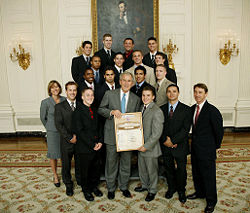 The 2008 Sooners men's gymnastics team, including 2008 Nissen-Emery Award winner Jonathan Horton, are honored at the White House by President of the United States George W. Bush upon the team's winning the 2008 national championship.
The 2008 Sooners men's gymnastics team, including 2008 Nissen-Emery Award winner Jonathan Horton, are honored at the White House by President of the United States George W. Bush upon the team's winning the 2008 national championship.
The men's gymnastics program at OU is headed by coach Mark Williams. It has won five of the last seven NCAA Men's Gymnastics championships, winning the title in 2002, 2003, 2005, 2006 and 2008 (they finished second behind Penn State in 2004 and 2007).[citation needed] Only Oklahoma and Penn State have won the NCAA title since 2000, with the exception of Ohio State in 2001. They won the 2006 title with very little experience on the team as 50% of the members were freshmen and just 21% were upperclassmen (seven freshmen, four sophomores, one junior, and two seniors).[citation needed] Teams from OU also won national championships in 1977, 1978, and 1991.[citation needed]
Gymnastics began at the school in 1902. The program folded in 1917 when the original coach left. The program was revived in 1965 with the new coach, Russ Porterfield having to beg students to join the squad. Within 6 years, OU had its first winning season. OU's next coach, Paul Ziert, turned the program into one of national prominence. He led OU to two national championships in 1977 and 1978. One of Ziert's athletes, Greg Buwick, would replace him as head coach in 1980 and would lead the team to its third national title in 1991. Buwick's assistant of 12 years, Mark Williams, took over the head coaching position in 2000 and has continued OU's tradition of gymnastics excellence. OU has produced more Nissen Award winners than any other university and is the only school to have back-to-back Nissen Award winners.[8]
Baseball
Main article: Oklahoma Sooners baseballThe Oklahoma Baseball tradition is long, proud and storied, with two National Championships in 1951 and 1994, along with numerous All-Americans. Their home field is L. Dale Mitchell Baseball Park, named after famed player Dale Mitchell. The current coach is Sunny Golloway. The baseball program was a source of recent controversy when the head coach, Larry Cochell, resigned after making racially insensitive remarks about one of the players on the team.
During the 2005–2006 season, the Sooners were given a home regional at L. Dale Mitchell Park and were named the No. 1 seed. They beat the University of Houston, Texas Christian University, and Wichita State University to win the regional and advanced to a Super Regional where they were defeated by Rice University in a best-of-three series. Oregon State University went on to win the College World Series that year.
Prior to 2006, the Sooners hosted regionals at minor league parks in Oklahoma City, first All Sports Stadium and then AT&T Bricktown Ballpark. Scheduling conflicts with the Oklahoma Redhawks, the Class AAA affiliate of the Houston Astros, led OU to bid for future regionals at its on-campus stadium.
Women's basketball
Main article: Oklahoma Sooners women's basketballOU Women's Basketball began during the 1974–75 academic year. It wasn't until 1996 when OU hired local high school basketball coach, Sherri Coale, that the team became something Sooners would be proud of. At one time the team drew an average of 65 people per game, now the Sooners are one of the nation's leaders in attendance. In 2002, Oklahoma advanced to the National Title game before losing to the Connecticut Huskies.
Wrestling
The wrestling program is the fourth most decorated in college wrestling, having won seven national championships in 1936, 1951, 1952, 1957, 1960, 1963 and 1974. The Sooners are considered a power in their own right and Bedlam matches draw an enormous crowd. There are numerous All-Americans and National Champions. Their greatest wrestlers are 3-time NCAA Champion and NCAA Outstanding Wrestler Mickey Martin; 2-time NCAA Champion and 2-time NCAA Outstanding Wrestler Tommy Evans; 3-time NCAA Champion and 2-time Outstanding Wrestler Dan Hodge (Hodge was never taken down and pinned his way through the NCAA's his Senior year); NCAA, World and Olympic Champion Wayne Wells; 3-time NCAA Champion, NCAA Outstanding Wrestler, 2-time World Champion and Olympic Champion Mark Schultz; NCAA Champion, World Champion, and Olympic Champion Dave Schultz; 2-time NCAA and World Champion Melvin Douglas.
Women's rowing
On May 10, 2007 the University announced the addition of women's rowing to the intercollegiate athletics program started by well respected rower Candie Garrett.[9] The University hired head coach Leeanne Crain in the spring of 2008. Assistant Coaches Kris Muhl and Andrew Derrick followed Crain from the University of Central Florida to jumpstart OU's program. Muhl took a head coaching position at the University of Jacksonville during summer 2009. Former UVA rower and Alabama Novice coach Marina Traub was hired as the varsity assistant coach in Fall 2009. Traub Named Asst. Rowing Coach
The University of Oklahoma women's rowing team practices in the Oklahoma City River (formerly the Canadian River), located in the Bricktown area of Oklahoma City. The river was designated as a U.S. Olympic Training Center for the sports of kayaking, canoeing and rowing on July 28, 2009. The University's boathouse is expected to be completed in early 2011.
Rivalries
University of Texas
The University of Texas is one rival of the Sooners. Regardless of the trademark implications, inverted versions of the Longhorn mascot can be seen on automobiles all over the Norman campus, and many T-shirts referring to the rivalry present the word "Texas" in mirror image, upside-down, or possibly surrounded by obscenities. A reminder of the rivalry shared by these two schools was painted on the South Oval of the OU campus for many years, and was recently replicated near the Library clock tower due to construction at its original site.
The annual game between the schools at the Cotton Bowl in Dallas, Texas, known as the Red River Rivalry, is a game that draws attention from the college football world.
University of Nebraska
See also: Nebraska–Oklahoma football rivalryA traditional college football rivalry with the University of Nebraska has been less intense over the past several years (although recent off-the-field incidents have heightened the animosity between the two programs and their respective fanbases). This is mainly due to the split-division nature of the Big 12 that now only allows the teams to play each other twice every four years. Prior to this, these teams were involved in several historic match-ups, including the Game of the Century and the so-called Game of the New Century where the teams have come in to the game ranked one and two in the Associated Press Poll, making the games of great importance in deciding the national championship. Historically, the rivalry's most distinguishing quality has been the grudging respect and appreciation between the two tradition-rich programs. Also of note is the game's former status as the premier Thanksgiving Day game for the middle of the country. The Sooners and Cornhuskers went head-to-head in the 2006 Big 12 Championship Game, with Oklahoma winning the conference title by the score of 21–7. The two teams also met in the 2010 Big 12 Championship Game, with Oklahoma again the victor in a close game by a score of 23–20.
Oklahoma State University
Oklahoma's primary rivalry is with an intrastate team, the Oklahoma State Cowboys, and is often referred to as the "Bedlam Series." It is normally played as a home-and-home series with games alternating between Norman and Stillwater, with the exception of the baseball teams, who often play at AT&T Bricktown Ballpark in Oklahoma City or ONEOK Field in Tulsa. Oklahoma currently leads the series 82–16–7 in football, and 124–88 in basketball[10] In baseball the series is tied at 147–147, and in wrestling Oklahoma trails the series 27–128–9.
Traditions
The "fight song" of the University of Oklahoma is "Boomer Sooner", a version of "Boola Boola", the fight song of Yale University, combined with a version of "I'm a Tar Heel Born", the fight song of the University of North Carolina at Chapel Hill. "Boomer Sooner" was written by Arthur M. Alden in 1905. Other songs played at athletic events by The Pride of Oklahoma Marching Band are a version of Rodgers and Hammerstein's "Oklahoma!", "OK Oklahoma", played after extra points, and the "OU Chant." At home games, The Pride of Oklahoma Marching Band plays that visiting team's "fight song" while facing their fans.
The Mascot present at all football games is the Sooner Schooner, a Conestoga wagon, pulled by two crème white ponies, Boomer and Sooner. The caretakers of the wagon are the spirit group called the RUF/NEKS, who shoot off modified shotguns in celebration of scores by the home team. The group was launched in 1915 when an elderly female spectator at an OU-Oklahoma A&M basketball game chided the group for raising hell ("Sit down and be quiet, you roughnecks!")[11]
Recently, in time for the 2005 football season, two new mascots, based on the ponies who pull the Schooner, were created, named appropriately, Boomer and Sooner. They are costumes of two identical (except for eye color) crème white ponies. Before, the Boomer and Sooner costume mascots, OU was also represented by Top Dawg. Top Dawg did some appearances at football games, but was primarily used at wrestling and basketball events.
The official school colors are Crimson and Cream, with red and white sometimes used as substitutes for simplicity.[12] The school logo is an interlocking OU design and was first used on football helmets in 1967.
National championships
- Men's
- Baseball: 1951, 1994
- Football: 1950, 1955, 1956, 1974, 1975, 1985, 2000
- Golf: 1989
- Gymnastics: 1977, 1978, 1991, 2002, 2003, 2005, 2006, 2008
- Wrestling: 1936, 1951, 1952, 1957, 1960, 1963, 1974
- Women's
- Softball: 2000
Notes
- ^ Oklahoma Sooners teams compete in the Big 12 Conference for all sports excluding rowing, which competes in Conference USA.
References
- ^ America's Best Sports Colleges CNNSI.com. October 7, 2002.
- ^ Division I-A All-Time Points Scored College Football Data Warehouse.
- ^ Soonersports.com. OU Football Quick Facts. Retrieved on August 21, 2007.
- ^ SoonerSports.com. Seven National Championships. University of Oklahoma. Retrieved on August 21, 2007.
- ^ No. 1 program of the modern era. University of Oklahoma. Retrieved on August 21, 2007.
- ^ Past Division I-A Football National Champions. www.ncaa.org
- ^ "Sampson barred from off-campus recruiting". http://sports.espn.go.com/ncb/news/story?id=2457878. Retrieved February 22, 2008.
- ^ SoonerSports.com Seven Nissen Emery Award Winners. University of Oklahoma. Retrieved on August 21, 2007.
- ^ "OU Athletics Adds Women's Rowing". The University of Oklahoma Department of Intercollegiate Athletics. May 10, 2007. Archived from the original on August 9, 2007. http://web.archive.org/web/20070809095849/http://alumni.ou.edu/news/news4.html. Retrieved August 21, 2007.
- ^ http://en.wikipedia.org/wiki/Bedlam_Series
- ^ Road Trip: University of Oklahoma. Sports Illustrated: On Campus. September 9, 2004.
- ^ SoonerSports.com. Official OU Athletics Style Guide. University of Oklahoma. Retrieved on August 21, 2007.
External links
University of Oklahoma Athletics Facilities Culture Football Seasons · Coaches · In the NFL Draft · Red River Shootout · Red River Shootout trophies · All-Americans · Starting QBs · Current seasonBasketball Other sports Baseball · Baseball coachesCampus List of buildings · Student Union · National Weather Center · Natural History Museum · Museum of Art · Bizzell Memorial Library · Boyd HouseStudent life Big 12 Conference Current teams Baylor Bears • Iowa State Cyclones • Kansas Jayhawks • Kansas State Wildcats • Missouri Tigers (Leaving in 2012) • Oklahoma Sooners • Oklahoma State Cowboys • Texas Longhorns • Texas A&M Aggies (leaving in 2012) • Texas Tech Red Raiders
Former teams Future teams TCU Horned Frogs (joining in 2012) West Virginia Mountaineers (joining in 2012)
Championships & awards Conference USA East Division West Division Soccer-only members Kentucky Wildcats (men's) • South Carolina Gamecocks (men's) • FIU Golden Panthers (men's) • Colorado College Tigers (women's)
Rowing-only members Alabama Crimson Tide • Kansas Jayhawks • Kansas State Wildcats • Oklahoma Sooners • Tennessee Volunteers • Texas Longhorns
History Sports teams in Oklahoma Baseball 
Basketball Football Hockey Soccer College athletics Categories:- Oklahoma Sooners
- College sports teams in the United States by team
- College sports teams in Oklahoma
- Men's sports
Wikimedia Foundation. 2010.

